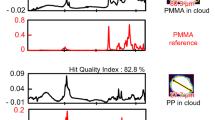Abstract
The effect of ammonium sulfate ((NH4)2SO4) on the condensation of low-volatile organic compounds in atmospheric aerosol is considered. Using the UNIFAC model, a physicochemical analysis has been conducted for the condensation of ISNP—a product of photochemical transformations of isoprene and α-pinene in the atmosphere. The variability of the mass content of ISNP, mass concentration of aerosol particles, and their phase state at different temperatures (T) and relative humidities (RH) have been calculated. Transition of the organic component into the aqueous phase of ammonium sulfate particles is observed only at certain combinations of T and RH. In comparison with condensation in the absence of ammonium sulfate, the ISNP content at given T and RH can be lower or higher. The results of calculations indicate that the newly forming particles of mixed composition are characterized by a higher hygroscopicity and a higher capacity to be converted into drops (miscible liquid phase) at an air humidity lower than for particles that contain only ammonium sulfate.
Similar content being viewed by others
REFERENCES
J. H. Seinfeld and S. N. Pandis, Atmospheric Chemistry and Physics: From Air Pollution to Climate Change (John Wiley & Sons, New York, 2006).
M. Kanakidou, J. H. Seinfeld, S. N. Pandis, et al., “Organic aerosol and global climate modeling: a review,” Atmos. Chem. Phys. 5 (4), 1053–1123 (2005).
M. L. Smith, A. K. Bertram, and S. T. Martin, “Deliquescence, efflorescence, and phase miscibility of mixed particles of ammonium sulfate and isoprene-derived secondary organic material,” Atmos. Chem. Phys. 12 (19), 9613–9628 (2012).
M. Jang, N. M. Czoschke, S. Lee, and R. M. Kamens, “Heterogeneous atmospheric aerosol production by acid-catalyzed particle-phase reactions,” Science 298, 814–817 (2002).
J. H. Kroll, A. W. H. Chan, N. L. Ng, R. C. Flagan, and J. H. Seinfeld, “Reactions of semivolatile organics and their effects on secondary organic aerosol formation,” Environ. Sci. Technol. 41 (10), 3545–3550 (2007).
Z. F. Lu, J. M. Hao, H. Takekawa, L. H. Hu, and J. H. Li, “Effect of high concentrations of inorganic seed aerosols on secondary organic aerosol formation in the m-xylene/NOx photooxidation system,” Atmos. Environ. 43 (4), 897–904 (2009).
H. Saathoff, K. H. Naumann, M. Schnaiter, W. Schock, O. Mohler, U. Schurath, E. Weingartner, M. Gysel, and U. Baltensperger, “Coating of soot and (NH4)2SO4 particles by ozonolysis products of alpha-pinene,” J. Aerosol Sci. 34 (10), 1297–1321 (2003).
S. Takahama, R. K. Pathak, and S. N. Pandis, “Efflorescence transitions of ammonium sulfate particles coated with secondary organic aerosol,” Environ. Sci. Technol. 42 (7), 2289–2295 (2007).
A. K. Bertram, S. T. Martin, S. J. Hanna, et al., “Predicting the relative humidities of liquid-liquid phase separation, efflorescence, and deliquescence of mixed particles of ammonium sulfate, organic material, and water using the organic-to-sulfate mass ratio of the particle and the oxygen-to-carbon elemental ratio of the organic component,” Atmos. Chem. Phys. 11 (21), 10995–11006 (2011).
M. L. Smith, M. Kuwata, and S. T. Martin, “Secondary organic material produced by the dark ozonolysis of alpha-pinene minimally affects the deliquescence and efflorescence of ammonium sulfate,” Aerosol Sci. Tech. 45 (2), 244–261 (2011).
A. N. Ermakov, A. E. Aloyan, and V. O. Arutyunyan, “On the effect of air humidity on the formation of organic aerosol particles in the atmosphere,” Opt. Atmos. Okeana 32 (2), 141–146 (2019).
A. G. Gorshkov, I. I. Marinayte, V. A. Ovolkin, G. I. Baram, and T. V. Khodger, “Polycyclic aromatic hydrocarbons in the snow cover of the southern coast lake Baikal,” Atmos. Oceanic Opt. 11, 780–784 (1998).
V. F. Raputa, T. V. Khodzher, A. G. Gorshkov, and K. P. Kutsenogii, “Some patterns in the pollution of the environs of Irkutsk by polyaromatic hydrocarbons,” Opt. Atmos. Okeana 11 (6), 650–653 (1998).
K. B. He, F. M. Yang, Y. L. Ma, Q. Zhang, X. H. Yao, C. K. Chan, S. Cadle, T. Chan, and P. Mulawa, “The characteristics of PM2.5 in Beijing, China,” Atmos. Environ. 35 (29), 4959–4970 (2001).
Y. Linuma, C. Miller, O. Bode, T. Gnauk, and H. Herrmann, “The formation of organic sulfate esters in the limonene ozonolysis secondary organic aerosol (SOA) under acidic conditions,” Atmos. Environ. 41 (27), 5571–5583 (2007).
A. E. Aloyan, A. N. Yermakov, and V. O. Arutyunyan, “Dynamics of gas admixtures and aerosols in forest and peat fires,” Russ. J. Numer. Anal. Math. Modell 29 (2), 79–92 (2014).
S. D. Brooks, M. E. Wise, M. Cushing, and M. A. Tolbert, “Deliquescence behavior of organic/ammonium sulfate aerosol,” Geophys. Rev. Lett. 29 (19), 23-1–23-4 (2002).
H. K. Hansen, P. Rasmussen, A. Fredenslund, M. Schiller, and J. Gmehling, “Vapor-liquid equilibria by UNIFAC group-contribution. 5. Revision and extension,” Ind. Eng. Chem. Res. 30 (10), 2352–2355 (1991).
Extended AIM Aerosol Thermodynamics Model, www.aim.env.uea.ac.uk/aim/aim.php.
B. D. Amiro, J. B. Todd, B. M. Wotton, et al., “Direct carbon emissions from Canadian forest fires, 1959–1999,” Can. J. For. Res. 31 (3), 512–515 (2001).
J. F. Pankow, “An absorption model of gas/particle partitioning of organic compounds in the atmosphere,” Atmos. Environ. 28 (2), 185–188 (1994).
Th. Koop, K. S. Carslaw, and Th. Peter, “Thermodynamic stability and phase transitions of PSC particles,” Geophys. Rev. Lett. 24 (17), 2199–2202 (1997).
Funding
This study was supported by the Russian Foundation for Basic Research, project nos. 18-05-00289, 19-05-50007, and 20-05-00044, as well as the state tasks of the Institute of Numerical Mathematics, Russian Academy of Sciences, and the Talrose Institute of Energetic Problems of Chemical Physics, Russian Academy of Sciences, project no. AAAA-A20-120011390097-3.
Author information
Authors and Affiliations
Corresponding authors
Additional information
Translated by V. Arutyunyan
Rights and permissions
About this article
Cite this article
Yermakov, A.N., Aloyan, A.E. & Arutyunyan, V.O. Mutual Impact of Mineral and Organic Components in Atmospheric Aerosol. Izv. Atmos. Ocean. Phys. 56, 72–78 (2020). https://doi.org/10.1134/S000143382001003X
Received:
Revised:
Accepted:
Published:
Issue Date:
DOI: https://doi.org/10.1134/S000143382001003X




